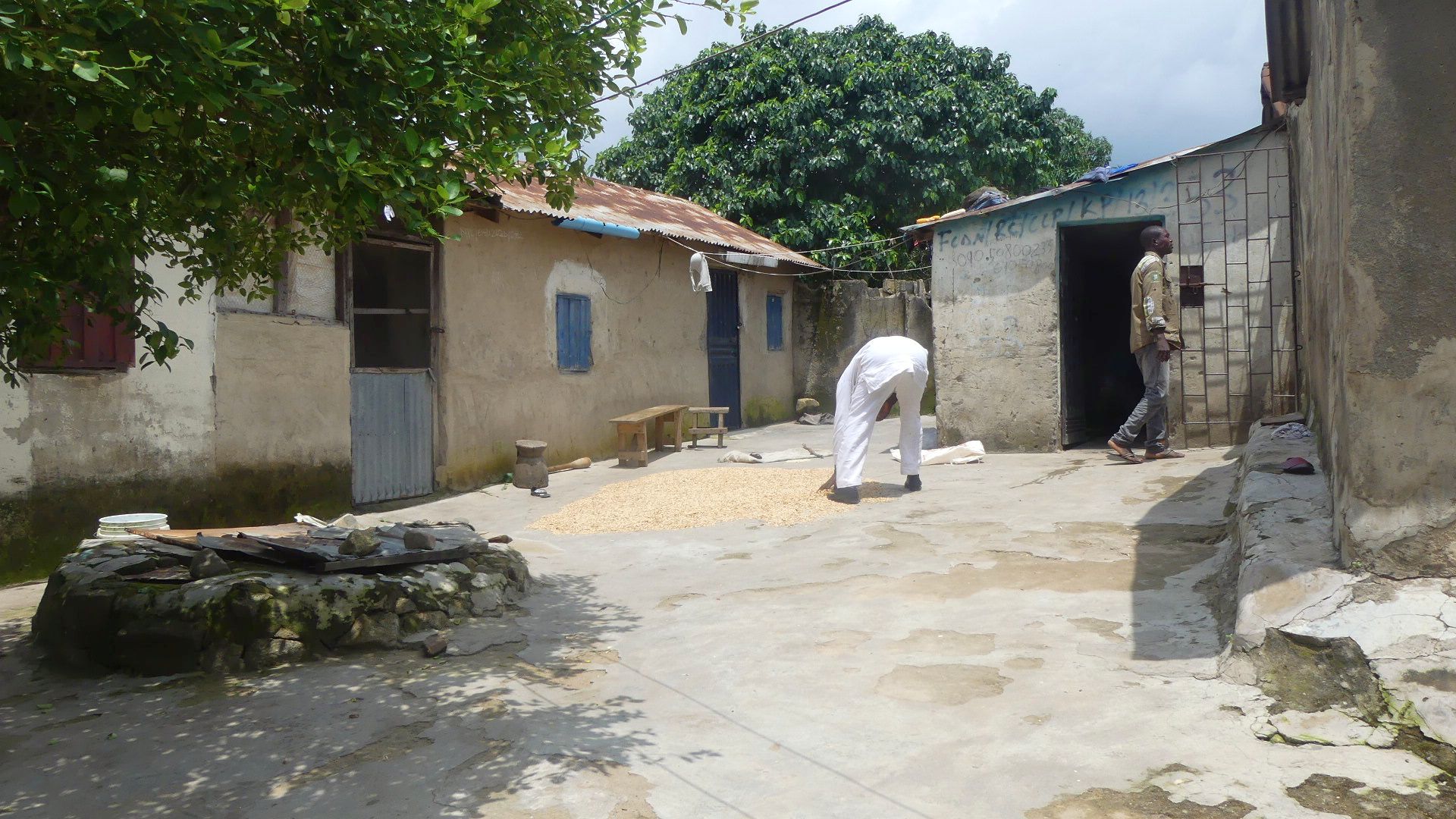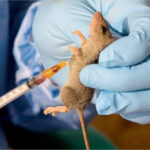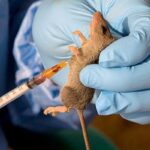by Nnenna Ibeh & Judd-Leonard Okafor
A mother of six children, 50-year-old farmer Ladi Isaac, is a lynchpin in preventing the next outbreak of Lassa fever in Abuja.
She is the epitome of a basic lesson in Epidemic Preparedness 101: physical insecurity compromises health security. And prioritising one at the expense of the other is a huge mistake.
She grows groundnuts, melon, maize, guinea corn, millet and beans. The grain harvest begins with her cutting down stalks and leaving the cobs of corn to dry out on the farm in the sun, husks intact. Later she would gather the husked cobs home for the next stage.
But threats from herds of cattle roaming for pasture and eating up—or destroying—entire farmlands of crop and harvest, have forced the farmers of Kpanyi Kpanyi to find other ways of sun-drying their harvest.
Isaac harvests her fresh cobs and drags them home. She dehusks them, lays out the cobs or decobbed grains on a plastic sheet on the ground to dry in the sun while she stands guard.
“Any day I spread my crops here, I have to stand outside on guard and watch for birds, fowls or any other animals that may come near,” she explains in pidgin English.
Also on her watch list are the rats that have been linked to Lassa fever. An outbreak of Lassa fever has been hitting the country every year since it was first identified in 1969.
And 52 years later, the country is still facing an outbreak. In the second week of September, four new cases of Lassa fever were confirmed in the ongoing outbreak, brining the total number of confirmed cases since the start of 2021 to 369. More than 14 states are already affected.
For the same period last year, the number of confirmed infections of Lassa fever stood at 1,078.
And the key is human contact with Lassa virus through exposure to food or household items contaminated with urine or faeces of infected mastomys rat.

Hidden away
The yard in front of Isaac’s home is her personal drying space. Surfaces of rock flattened out by weathering dot the landscape of Kpanyi Kpanyi.
Two expansive flats adorn the community, and that is where households take turns to dry their crops throughout the week. They have to hope for the rain, weather the rain and beat away rats that run from vegetation and undergrowth across their drying crops. The mastomys rat is common in equatorial Africa.
The age-old farming practices that have morphed in response to present challenges could hold the key to pockets of the Lassa fever outbreak in Abuja.
The largely Gbagyi community of farmers is one of many along the long, wide stretch of tarmacked road into the country’s capital city and seat of power. It is hidden away behind a fence a few footsteps from the highway corridor.
It supplies the foodstuff market of the capital city. It is also a vehicle for travellers ferrying cheaply gotten foodstuff to other states in transit.

Uncertain hygiene drying processes
Across regions where Lassa fever is endemic, an estimated 100,000 to 300,000 infections occur annually, with approximately 5,000 deaths, according to the Centre for Disease Control.
It is predominant in Nigeria in the dry season—more known as Harmattan—a time when bush burning as farmers prepare land for planting chases rats out of vegetation.
It begins with an exposure to the virus—and 80 in 100 people infected with the virus have no symptoms. And then onward to human-to-human transmission.
Symptoms range from fever and diarrhoea to vomiting, abdominal pain, sore throat, haemorrhaging and organ failure that can lead to death.
The possibilities abound for an infectious disease slipping through gaps in the crop drying process of communities like Kpanyi Kpanyi, but the awareness is limited.
An outbreak of cholera had already set in before August. Without a health centre of its own, many patients from the community were hospitalised at Kuje General Hospital. The hospital was jokingly referred to as Kpanyi Kpanyi. Yet for a long while, the community was not aware of the outbreak of cholera among its residents.
Outbreak risk and communication efforts have been ongoing online and offline, but forgotten communities like Kpanyi Kpanyi are well beyond reach.
Anthony John, a 40-year-old youth leader who grows soybeans, maize, guinea corn, beans, believes God’s protection has been saving the people.
“While it is God that protects us, over safety and hygiene, even in the farm, the birds that are flying can perch on them and even excrete on the crops, even rats. In the compound, the only issue we have is fowls and birds.”
It hasn’t always been this bad. Older farmers built granaries, large rhombuses lifted off the ground on stilts, to store grains. The granaries made of fired mud or clay came with features to keep them off the ground—away from rodents, other animals and flooding.

A couple of them still dot Kpanyi Kpanyi, all of them older than John and fallen to the vagaries of time and weather.
“This one was built many years ago, and we can’t use it anymore,” says John, indicating one close to the chief’s abode.
Rhombuses are to grain farmers in the north what yam barns are to tuber farmers in the east. They are a common feature of grain farming communities in the north but fast becoming a technology lost to farmers facing modern challenges.
“Many years have gone by. Children, even me at my age I cannot be able to build a granary today,” says John. “Even if I manage to build it, can I have the strength to manage it?”
To address the challenge of storage space, John said, farmers who can afford it, build a cemented platforms a few inches above the ground for drying their crops.
“What always happens is that when we bring our harvested crops to the house, sometimes it mixes with sand and this is not good to eat,” John said.
“Unless someone has a house that is cemented, then you can have a safe drying space. But if you don’t have a house like that, you’ll buy a trampoline and spread the harvested crops on it,” he added.
Sometimes the villagers use a flat rock up the hills for drying their crops; in this case, the owners of the crops would hang around to avoid losing their goods to thieves.
He also hopes that better drying equipment could be made available to alleviate the troubles and improve the hygiene of the crop drying process.
“We believe there must be some processing for crop drying and maintaining good hygiene, I can say there must be better innovations for better drying and storage process,” John said.

Preparing for recurring Lassa outbreak
The Nigeria Centre for Disease Control has been monitoring Lassa fever—among a handful of other high-priority diseases in the country. It keeps a week-by-week report of cases—probable, suspected, and confirmed—going back to 2017.
Trend analysis going back to 2017 show the bulk of infections is in the dry season, following the resident Harmattan of the country—a period that sits within the first 13 weeks of the year.
Since there seems to be an outbreak of Lassa Fever every year across Nigeria, it is important to note what the country is doing to prevent the disease outbreak, spread and treatment.
However, an analysis of the Federal Government approved budget for 2021 did not show plans for any interaction with farmers or capacity building for Nigerian farmers on storage.
The NCDC in its budget mapped out N36 million for a nationwide study of public health priority disease for Lassa Fever, meningitis, dengue fever and yellow fever.
The centre is only one of a list of ministries named to collaborate on the National Action Plan for Health Security 2018-2022. It is smackdab in the ongoing legislation to change the nearly century-old Quarantine Act, but it cannot work alone.
“This will require not only substantial funding, but also stable funding that meets evolving needs and novel technologies,” director-general of NCDC, Chikwe Ihekweazu, months before he is to leave the NCDC to take up an appointment with the World Health Organisation in Germany.
“While recognising the need to invest in diagnostics, we must not neglect the other aspects of epidemic preparedness including those that are not within the direct control of the health sector.”

Monies and priorities
The list includes the ministries of agriculture, environment, health amongst others—and the National Orientation Agency is the government’s vehicle on public communication and awareness for national development.
It has been vocal since the outbreak of coronavirus but has historically been silent on Lassa fever.
Among 11 projects in NOA’s 2017 budget, there is no mention of risk communication or disease outbreak communication, but hospitals like Federal Medical Centre budgeted N14m for lassa fever public campaign and control while the ministry of science and technology earmarked N8.6m for genomics-enabled diagnosis and treatment operation for viral haemorrhagic diseases, which include lassa fever.
In 2018, NOA budget did not mention Lassa fever or infection communication. The SciTech ministry retained its genomics project for an increased N60m and the environment ministry introduced “deratization, pest and vector control” for Lassa fever for N15m in Anambra.
The federal health ministry introduced “strengthening public health against Lassa fever” for N1.5 billion and Federal Teaching Hospital, Abakaliki proposed to procure diagnostic equipment for N70m.
NOA’s budget from 2019 to 2021 did not mention Lassa fever or infectious disease risk communication. Any mention of Lassa fever in its programmes would have to contend with ongoing cholera and COVID-19.
Nigeria’s index case of COVID-19 prompted NOA to “begin to warn people about cleaning their environment especially those who have the habit of eating certain animals including rodents to desist from such or cook them very well if them must eat it,” said Paul Odenyi, NOA’s assistant director of press.
The crucial Harmattan months for Lassa fever loom—and NOA has to find a way to reach all 774 council areas of the country.
“We use town hall meetings as strategy meeting points to enlighten and educate the people about these diseases, their effects and ways to prevent their spread. At the two hall meetings, we have our enlightenment officers, public health officials, traditional and community leaders including youth leaders too,” says Odenyi.

Missing the grain for the harvest
Among new strategies it is open to is engaging farmers.
“I think you’re bringing in a new perspective to it that is interesting and this is one of the things we add to our media discussion issue for the director-general of NOA.
“We would look for ways we can collaborate with the ministry of agriculture and rural development and even the ministry of water resources to draft our campaigns and engagement plans with farmers on the need for us to store our food crops in a more hygienic manner,” he added.
The chief of Kpanyi Kpanyi, Etsu Amos Paink Paink, hopes for a time when his community can afford plastic vats to keep stored grains from the reach of rodents.
It would be an immediate relief, but the agriculture ministry is looking to ambitious “secure silos across the country” to store assorted grains, in effect preventing contamination and pollution, according to Theodore Ogaziechi, a director of information at the federal ministry of agriculture and rural development.
The ministry is also getting on with training of agricultural extension agents to educate farmers on how to grow healthy crops, preserve and store them for healthy consumption.
“Beyond these efforts, the Department of Veterinary and Pest Control in the Ministry also embarks on periodic aerial and ground sprays of pesticides to eradicate pest infestations in farms,” Ogaziechi said.
That’s discounting the post-harvest handling at Kpanyi Kpanyi. It comes down to a single grain exposed to a rodent. An epidemic is not a matter of if, but when.
After 50+ years, standing ready to deal with Lassa fever—in the absence of a vaccine—starts with preventing it. That requires orientation and information, backed with sustainable funding to ensure the next outbreak is prevented.
This story is part of the Epidemic Preparedness and Response series, with support from the “Global Health Advocacy Incubator, A Program of the Campaign for Tobacco Free Kids” and “Vital Strategies.” Photographs by Nnenna Ibeh & Judd-Leonard Okafor

 Join Daily Trust WhatsApp Community For Quick Access To News and Happenings Around You.
Join Daily Trust WhatsApp Community For Quick Access To News and Happenings Around You.
